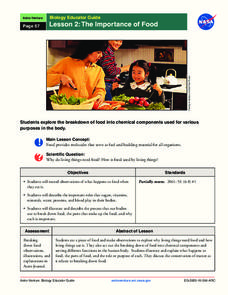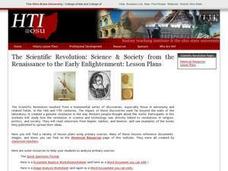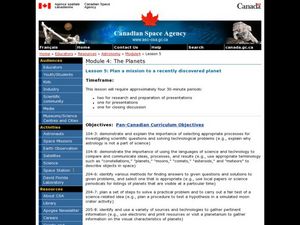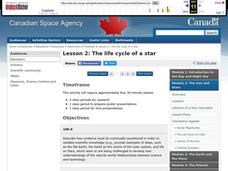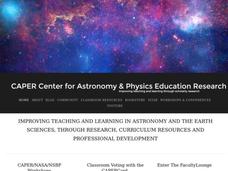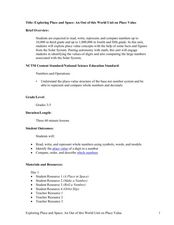Curated OER
How Far... How Powerfu
Students work with a real optical spectrum of a gamma ray burst afterglow taken at the Keck Observatory. They measure the shifts of spectral lines, deduce the velocity of the astronomical object, and then use Hubble's Law to get its...
Curated OER
How Hot is that Star?: Astronomy, Sun, Solar Temperature, Science
Students explain sun facts and solar information. They discover how temperature of a star is measured. They investigate the various scales used to measure temperature. They observe images of the sun. They classify stars according to te
Curated OER
Planet Picking
Students arrange the planets according to their distances from the sun. In this astronomy lesson, students list interesting properties about each planet. They identify an unknown planet photo.
NASA
The Importance of Food
Pupils make observations while eating food. They act out the process of food breaking down in the body and the roles of various chemical components, such as sugar and protein. It concludes with an activity illustrating the process and a...
Curated OER
Hubble Space Telescope
Students investigate the universe through the eyes of the Hubble space telescope. They conduct research from looking at the universe that is simulated with a digital projector. The images are projected onto the wall in a simulation of...
University of Colorado
Astro-Chronology
Class members play a version of the game Chronology to determine when certain scientific events occurred in history. Teams play until someone has 5-10 events in the correct order.
Curated OER
The Scientific Revolution
Scientists participate in studying how new scientific advances have changed the world. They explain how astronomers have changed the way people view the universe, summarize the advances that were made in chemistry and medicine, and...
Curated OER
Exploring Mars
Students, working in small groups construct scale models of the planets and solar system. They examine images of Mars and discuss what might have caused the features. They record facts about their planetary research in their journals and...
Curated OER
Plan a Mission to Recently Discovered Planet
Young scholars plan a mission to a recently discovered planet. In this science lesson plan, students research spacecraft design, distances in space, long-term missions in space, and life-sustaining planets. Young scholars work in groups...
Curated OER
Earth, Moon, Mars Balloons
Students demonstrate size and orbits of Earth, Moon, and Mars. In this space science lesson plan, students will use balloons to show how the size and distance between the planets and satellite compare.
Curated OER
Sky Pictures
Young scholars investigate constellations. In this space science lesson, students view transparencies of constellations and identify the zodiac constellations. Young scholars research the legends connected with the constellations.
Curated OER
LIFE IN SPACE Human Body: An Un-Earthly Home
Learners examine an effect of zero gravity on the human body using a baby food jar, balloons and a jar with a large mouth.
Curated OER
A DISAPPEARING ACT Astronomy: Do Stars Always Shine?
Students observe why stars are not visible during the day with a classroom demonstration using an index card punched with holes.
Space Awareness
The Intertropical Convergence Zone
Young scientists know it is hotter along the equator, but why is it also rainier? Through the process of completing two experiments and a worksheet, scholars discover the answer is the intertropical convergence zone. First, they...
Curated OER
Measuring the Diameter of Our Star
Learners conduct an experiment to measure the diameter of the sun. For this astronomy lesson, students construct a simple equipment to collect scientific data. They calculate the sun's diameter using a given formula.
Curated OER
Stargazing Astronomy: A Ceiling Full of Stars
Students make an observe a planetarium using a can with nail holes, black paper and a flashlight.
Curated OER
The Life Cycle of a Star
Young scholars investigate the life cycle of a star and make conclusions based on evidence, research, and observation. In this lesson on space and scientific investigation, students describe the relationships between science and...
Curated OER
Canadian Astronauts and Astronomers
Students research the web for Canadian nationals such as Marc Garneau, Roberta Bandar and Chris Hadfield who have contributed to science and technology. In this Astronauts and astronomers lesson plan, students work in groups and are...
Curated OER
The Expanding Universe
Learners explore the expanding universe. In this science lesson, students use balloons to model the expansion of the universe. Learners take measurements of the balloon expansion and answer questions directed to develop their...
Curated OER
Exploring Place and Space
Students explore number values by completing mathematical worksheets in class. In this decimals lesson, students identify the different place values a number has and the use of decimals to represent a fraction of a number. Students...
Curated OER
Timeline of Technology
Students choose an aspect of Astronomy to research. In this instructional activity on technology, students make a timeline of notable events in the development of astronomy and aerospace technology.
Curated OER
Chandra X-Ray Observatory
Students tour Chandra's top galactic X-ray images. In this Chandra X-Ray Observatory lesson, students play games and complete puzzles based on the Chandra Mission and X-Ray Astronomy. Students listen to pod casts, question an...
Curated OER
Properties of Dust
Students examine the dust in their classroom and relate it to the dust in space. In this investigative lesson students collect dust and graph their findings.
Curated OER
Star Search
Seventh graders explore stars. In this star lesson plan, 7th graders apply generalities about space objects to constellations and explore the differences between radio waves and light waves by answering essential questions in their...





